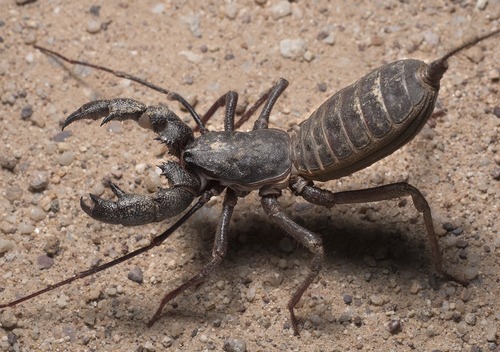Uropygi
 | |
| Kingdom: | Animalia |
|---|---|
| Subkingdom: | Bilateria |
| Infrakingdom: | Protostomia |
| Superphylum: | Ecdysozoa |
| Phylum: | Arthropoda |
| Subphylum: | Chelicerata |
| Class: | Arachnida |
| Order: | Uropygi |
The arachnid order Uropygi contains organisms more commonly known as whip scorpions or vinegaroons. Although they may be referred to as 'whip scorpions', they are not actually true scorpions (Order Scorpiones). The name 'vinegaroon' was coined off their unique ability to spray a mixture of acetic acid, caprylic acid, and water as a defense mechanism. Vinegar typically consists of 5–20% acetic acid; however, the chemical mixture secreted by vinegaroons typically contains up to 83% acetic acid, which can irritate and deter predators[3][4].
Characteristics and Morphology
As members of the class Arachnida, vinegaroons possess four pairs of legs. The first pair of legs are much thinner than the rest, as they are modified into sensitive, antenna-like structures. The remaining legs are used for walking. They have one pair of eyes on the front of their cephalothorax (front body segment) and up to five pairs on the sides. They are typically nocturnal and have poor eyesight, relying on their antenniform legs to sense their surroundings[5]. They bear a pair of large pedipalps, or appendages with pincer-like structures used for capturing and holding onto prey, defending against predators, or digging up soil for burrowing. They use their pair of chelicerae (mouthparts) to chew prey. Their opisthosoma (abdomen) consists of twelve body segments with a whip-like flagella (tail) on the end, explaining the name "whip scorpion". This tail has a similar use to their antenniform legs in sensing vibrations and olfactory chemicals in the air[6]. Vinegaroons have two pygidial glands at the base of their flagella where their vinegar-like secretions are produced. They can aim their tail towards predators when they feel threatened and release the acetic acid mixture with surprising accuracy[7]
Reproduction and Life Cycle
Diet and Feeding Behaviors
Distribution
References
- ↑ Integrated Taxonomic Information System (ITIS). n.d. Uropygi. https://www.itis.gov/servlet/SingleRpt/SingleRpt?search_topic=TSN&search_value=82710#null
- ↑ Maltais, B. (2016). The Vinegaroon: A Salad with Frankenstein [Photograph]. https://www.macrophotobug.com/vinageroon-whip-scorpion-arizona/
- ↑ Helmenstine, A.M. (2019). Vinegar Chemical Formula. ThoughCo. https://www.thoughtco.com/vinegar-chemical-formula-and-facts-608481
- ↑ Smolinske, S.C., S.A. Seifert, B.W. Warrick, & Y. Tadfor. (2022). Vinegaroon exposures reported to a Poison center. Toxicon. https://www.sciencedirect.com/science/article/abs/pii/S0041010122002732
- ↑ AnimalFact. (2024). Vinegaroon. https://animalfact.com/vinegaroon-uropygi/
- ↑ Texas A&M AgriLife Extension. n.d. Vinegaroon. https://texasinsects.tamu.edu/vinegaroon/
- ↑ PBS Deep Look. (2022).The Vinegaroon Sprays Acid to Foil Its Foes [Video]. https://www.pbs.org/video/the-vinegaroon-sprays-acid-to-foil-its-foes-3csgr1/